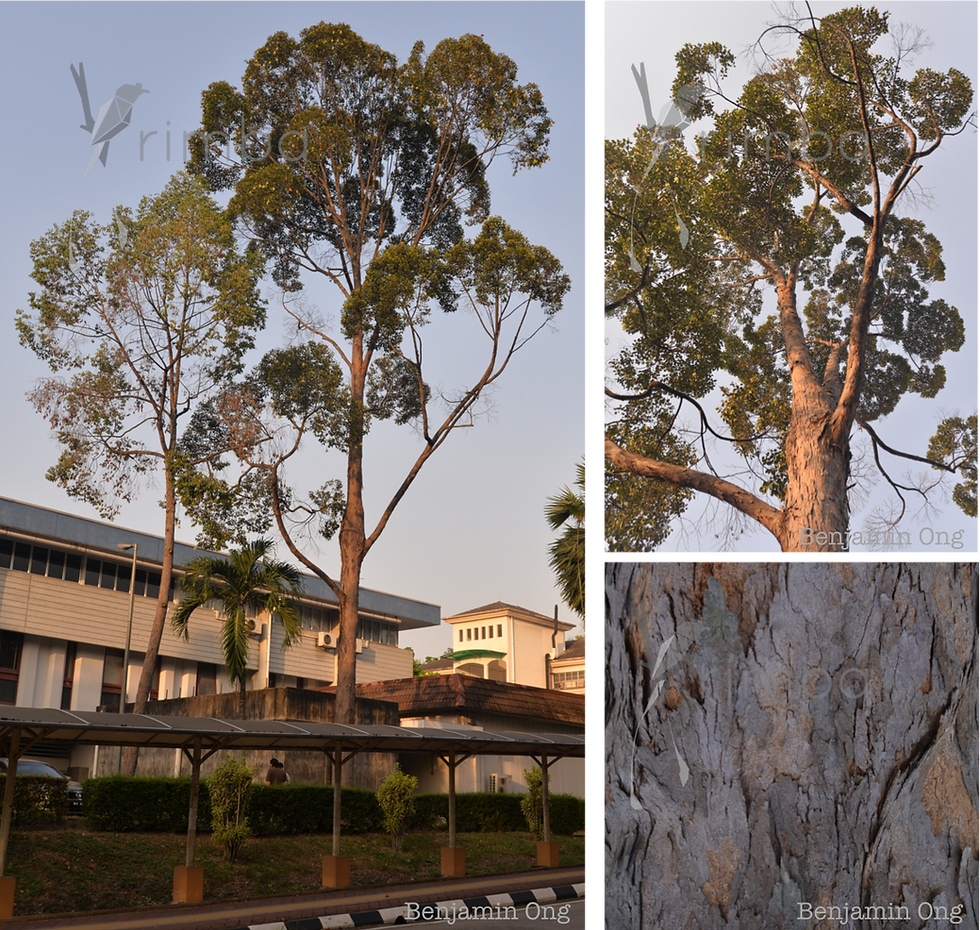The Borneo Camphor Tree
- umrimba

- Aug 6, 2014
- 2 min read
by Vanessa Ting

Kapur, or Borneo Camphor Tree (Dryobalanops aromatica) is a gigantic tree, growing up to a height of 60 metres. As a member of the Dipterocarpaceae family, it is a tropical rainforest tree known for its hardwood and resin production. As a matter of fact, its species name aromatica refers to the camphor resin produced by its bark, and was once prized by Indian and Arab merchants, with a price higher than gold's.
The distribution of Kapur trees is limited to Peninsular Malaysia, Borneo and Sumatera. Although they mostly grow in clusters, they demonstrate 'crown shyness', caused by a narrow gap between the canopies of trees where they do not overlap with each other, resulting in a 'jigsaw pattern' in the sky. You can see this awe-inspiring natural phenomenon in the Forest Research Institute of Malaysia (FRIM). On the UM campus, you can find some of these magnificent trees at the KL Gate, Rimba Ilmu and the Department of Geology.

(Above, left) Kapur tree at the Department of Geology, Faculty of Science. (Above, right) Canopy and bark detail of Kapur tree.
As with all Dipterocarps, the tree has a characteristic 'broccoli-shaped' crown. The bark peels easily and have been traditionally used by indigenous tribes to make the walls of their huts and in weaving. The leaves also have a camphor fragrance, and are five to ten cm long, with pointed ends which aid in rainwater run-off (drip tip) - an important feature in tropical rainforests! When dried, the leaves are an attractive reddish-brown with a shiny, lacquer-like appearance.
Its timber is extremely durable and valuable, and excessive logging, together with clearance of lowland forests, is causing the Dryobalanops, as well as other members of the Dipterocarpaceae, to become endangered. Flowering and seed production happens only once every three to four years.

(Above) The branches of this Kapur tree are heavily laden with seeds, which are dispersed by wind, aided in flight by their 'wings'.
The flowers are very fragrant, and appear white and small (about two centimetres wide). The seeds are large and attached to five wing-like sepals, which fall in spirals to the ground, like mini-helicopters! The seeds also produce camphor oil, which you can see if you squeeze them gently at the base.

(Above) Fallen Kapur seeds and leaves.
If you're lucky enough to come across a Kapur seed, do try grow a seedling out of it - remove the sepals and place the seed, rounded tip downwards, onto damp soil. When the seedling is large enough, plant it on a well-drained, clear area - it will grow to be a huge tree, so give it plenty of space!
Vanessa Ting is happiest when surrounded by books, although she finds herself thriving in the no-less-fascinating world of conservation biology, which mostly involves exponential (learning and topographical) curves, tagging behind ardent, energetic botanists and zoologists. She can be reached at vcc.ting@gmail.com.




























Hi, Thank you for the information on this post.
I just finished making a specimen card of the dried flowers of this Camphor tree. I was lucky enough to have been gifted these flowers by a dear one who found them when they visited Lake Gardens, KL, Malaysia. We live here but seldom realize the value of those that surround us - our natural resources!
I’m including this specimen card in a junk journal I’m making for friend who lives in Michigan, USA. I’m glad to have found out about this tree and its value to all of us.